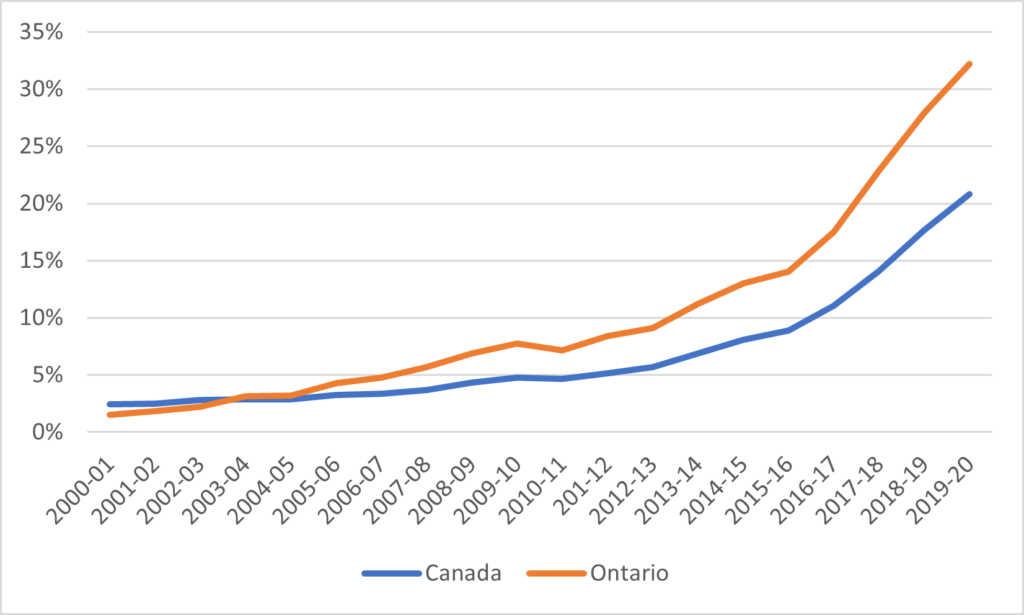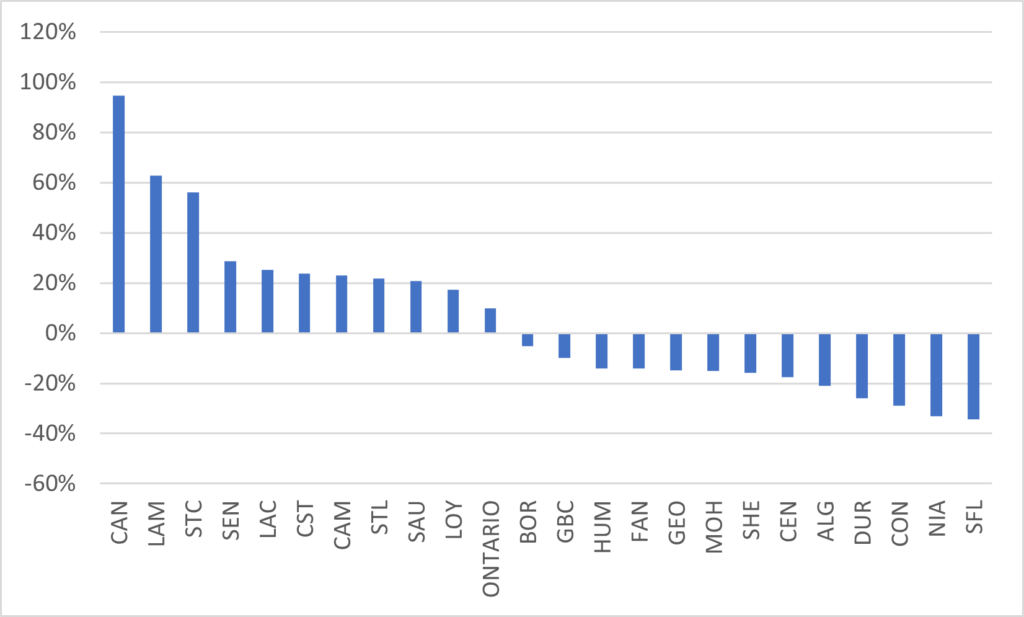If you want a peek into how I spent my days, come, join with me on a quest to try to get Canadian institutional data in less than 3 years. It’ll be fun, I promise. It’s about Ontario Colleges, which are never not interesting.
Let me show you two graphs which take us right up to the point where our national statistics agency’s data leaves off, 2019-20 (yes, really). The first is international students as a percentage of Ontario’s total enrolment with Canada as a comparator, and it shows that as of late 2019, Ontario colleges has a student body which is 33% international.
Figure 1: International Students as a Percentage of the College Student Body, Ontario vs. Canada

That Ontario Colleges have been drinking deeply from the international student hose is not news. What might be news is the financial consequences of this. Figure 2 shows total college income by source, in constant $2020. Some people may try to make out that colleges only turned to international students in response to government cutbacks, but this is plainly not true: the gains from international student fee income outstrip the losses from government “cuts” by a factor of about 8 to 1. Basically, thanks to rising international student numbers, fee income doubled between 2011-12 and 2019-20. Even after accounting for inflation, this makes Ontario Colleges pretty much the most financially healthy part of the Canadian post-secondary sector.
Figure 2: Total Revenues by Type, Ontario Colleges, 2001-02 to 2019-20, in millions of constant $2020

So now, here’s the question: what happened during the pandemic? StatsCan, all too predictably, will not have student numbers for Ontario in 2020-21 until December 2022, and no financial numbers until January 2023. But it is still possible to piece some things together. First, on student numbers, we can look at Government of Ontario open data on college enrolments, which is usually a good 6-8 months ahead of StatsCan (and provides a lot of data for free on topics for which StatsCan charges an unholy amount). While it counts students differently than StatsCan (the focus here is on full-time enrolments only), one cans still get a sense of trends over time. And figure 3 shows what happened in Ontario colleges during year 1 of the pandemic: institutional experiences varied widely, with nearly all schools experiencing either double-digit increases or decreases in international enrolment, but province-wide, there was an increase of 10% in enrolments. And yes, this was during a period where it was very difficult to get into the country.
Figure 3: Percentage Change in Reported International Students, by College, 2019-20 to 2020-21

(The sharp-eyed among you may notice that one college is missing, and that is due to the fact I had to remove Northern college because it broke the graph with an increase of 602 PERCENT due to its new PPP arrangement with Pures College in Toronto which attracted over 4,000 students in 2020-21. And yes, now that you ask, this is totally in contravention of Ontario Government’s Binding Policy Directive policy on PPP arrangements, which are meant to be limited to 2x the number of international students that are enrolled, but no one ever got rich betting on the Ford Government to enforce rules. Also, for clarity: there are about a half-dozen colleges which report large numbers of students whose visa status is “other” or “unknown”. For a variety of reasons, available upon request, my impression is that these are in fact international students and so have been included in the totals despite not technically being reported as international students.)
So, a 10% increase in student numbers – that means more money for Ontario colleges, right? Not so fast. Even though the numbers were up, data from schools’ annual financial statements (which are usually available a good 10-12 months ahead of StatsCan’s report on college finances), suggest something very different. In fact, as Figure 4 shows, across the system as a whole, fee revenue fell by 9%, leading to an overall revenue decline of 8%.
Figure 4: Percentage Change in Reported Fee Revenue, by College, 2019-20 to 2020-21

More or less, the institutions that did better on holding or increasing their student numbers also did better at holding or increasing their fee income, but it wasn’t really a one-to-one relationship. For instance, Northern increased its international numbers by 600% but only increased net revenue from international students/programs by 6%, which suggests that there was likely one hell of a lot of fee discounting going on at the various PPP colleges (and not just Northern). And not just fee-discounting for the purpose of attracting students: presumably a lot of ancillary/usage fees were way down in the COVID year, as was fee income for in-person prep terms of English as an Additional Language.
Anyways, long story short: Ontario Colleges have been making money hand over first from international students for over a decade, making it one of the most successful post-secondary sectors not just in Canada but in all the developed world. International student numbers increased during COVID, but fee revenues declined, either because of fee discounting, or the loss of revenues from programs which required face-to-face contact or both. In all likelihood, this decline in fee income is a one-off, and likely rebounded in 2021-22.
And as for 2022-23 and beyond? Absent any provincial policy changes, the Ontario college sector is heading towards becoming majority international student well before the end of the decade, possibly as soon as 2023-24. The finances virtually dictate it. The question is at what point politics intervenes.

 Tweet this post
Tweet this post

Much of this increase is due to international students who want to obtain permanent residency in Canada. This may be the fastest and cheapest option for many young people (i.e., compared to an immigration lawyer, being out of the country, and not having any Canadian credentials)? This is a hypothesis being tossed around by a few of my colleagues. Given the Statistics Canada release today on which you commented on Twitter, this seems to be the case. Also, is the 6% revenue increase for Northern College the result of only a small portion of revenue going from Pures to Northern College? While the student numbers include those taught by Pures under the Northern College brand?
If I’m an international student from any of the 14 Direct Stream countries looking to live and study at an Ontario college in the GTA, I certainly wouldn’t choose one of the private career colleges (Pures, Alpha Academy, Hanson, etc.) operating as unregulated licensees of Ontario public college programs.
Why would any financially savvy student, domestic or international, freely choose to pay upwards of 25% more to attend “Loyalist College Toronto” when it’s so easy to cut out the middleman and just register directly at one of the public colleges based in the GTA? George Brown? Humber? Seneca? Centennial? Or even Durham (Oshawa) or Sheridan (Oakville)?
Am I missing something here? Or is Apply Board failing to tell international students that there are a half dozen GTA-based public colleges that will happily take them (and charge less)?